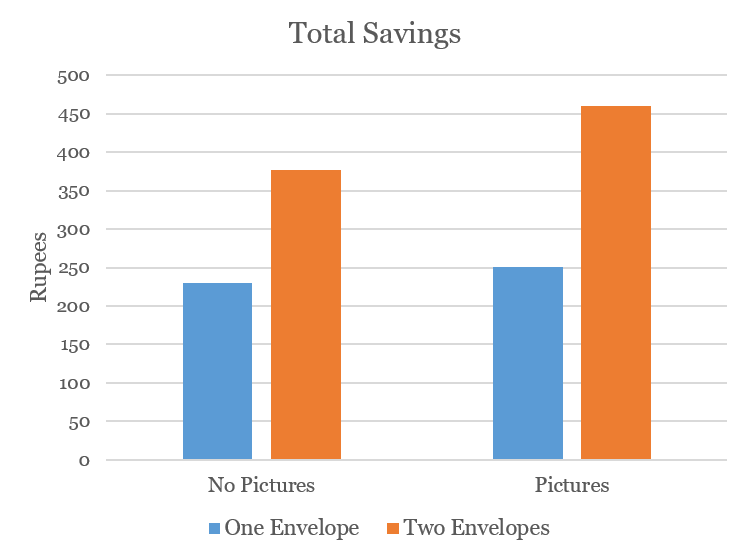
Divide Money to Save More
Organization : B-Hub Editorial Team
Project Overview
Project Summary
To encourage savings, male workers in rural India were assigned a financial saving goal. Each week, savings were set aside from each worker’s wages and placed in one or two sealed envelopes, some of which were decorated with pictures of their children.
Impact
Separating earmarked money into two envelopes increased average total savings by 72% over placing money into only one envelope.
Challenge
Saving money can be challenging, especially with limited access to financial institutions in rural areas. The World Bank estimates that as of 2014 only about half of Indian adults had an account at a financial institution and only 13% saved money there. Unsurprisingly, low-income households without access to banks save very little: the mean baseline savings rate observed by researchers was only 0.75%. Individuals who fail to save sufficient funds for their post-working years suffer from poverty and may end up using more public resources as a result. Therefore, researchers and policymakers are interested in designing ways to help people save more. Prior research suggests that earmarking money, or setting it aside for a specific purpose, increases self-control and promotes increased savings.
Design
Male construction workers in rural India who agreed to receive financial planning services were given a portion of their weekly income in envelopes and instructed to treat the earmarked money as savings. Participants were randomly assigned either high savings targets (~12% of income) or low savings targets (~6% of income) by financial advisors during an initial home visit.
During weekly return visits, social workers set aside money from the workers’ wages equivalent to their target savings in either one envelope, or split equally into two envelopes, and noted whether any savings had been spent from prior weeks. These envelopes were either plain white or decorated with photos of the participants’ children. This process lasted 15 weeks at which point total savings were analyzed.
Impact
A randomized evaluation found that workers who received their earmarked savings in two envelopes saved an average of 414 rupees, or 72% more than the 241 rupees saved by workers who received their savings in one envelope.
Workers who received envelopes with pictures of their children saved an average of 350 rupees, or 15% more than the 304 rupees saved by workers without pictures of their children.
The condition where workers received two envelopes and pictures of their children displayed the greatest savings. The interaction between partitioning and photos of children is illustrated below:

Savings were higher when the earmarked money was partitioned into two envelopes (p<.0001). The effect of pictures on savings was significant (p<.0001) only when the earmarked money was partitioned, not when pooled into one envelope.
Implementation Guidelines
Inspired to implement this design in your own work? Here are some things to think about before you get started:
- Are the behavioral drivers to the problem you are trying to solve similar to the ones described in the challenge section of this project?
- Is it feasible to adapt the design to address your problem?
- Could there be structural barriers at play that might keep the design from having the desired effect?
- Finally, we encourage you to make sure you monitor, test and take steps to iterate on designs often when either adapting them to a new context or scaling up to make sure they’re effective.
Additionally, consider the following insights:
Would this work elsewhere? Prior research suggests that earmarking increases self-control; results of this study may be generalizable where the following conditions also exist:
- All participants have similar professions and earnings, and do not have any unforeseen expenses (such as a medical emergency) during the study.
- Participants have no prior banking experience. Partitioning cash instead of electronic currency represents both physical and mental earmarking.
- Participants are paid often (e.g. weekly). Participants who are paid less frequently may exhibit different behaviors (i.e. needing to dip into savings as last month’s paycheck dries up OR thinking more long term instead of viewing finances as “one week at a time”).
Advice for Implementers:
- Observe and record baseline savings rates of the participants prior to the intervention.
- Seal the envelopes. Breaking the seal represents the breaking of a rule which is hypothesized to induce guilt. Additionally, it is an easy way to see if the participant opened the envelope.
- Select participants from broad geographic and social clusters to minimize the possibility of households discussing their participation.
- Printing pictures of their children on the envelope made the partitioning most effective. The visual reminder serves as a clear reason why the worker should save money. Similar research has found that reminding people of their savings goal can have a big impact on savings. (Karlan, McConnell, Mullainathan, & Zinman, 2016)
- A high saving target helped savings when divided into two envelopes, but hurt savings when only one was used. Because the high saving target is difficult to maintain, the use of multiple envelopes may help prevent households from sliding down a slippery slope of goal failure.
- Costs: Envelopes, pictures, and depending on the partnership, payment may be required to recruit social workers and financial advisors.
Project Credits
Researchers:
Dilip Soman University of Toronto
Amar Cheema University of Virginia


